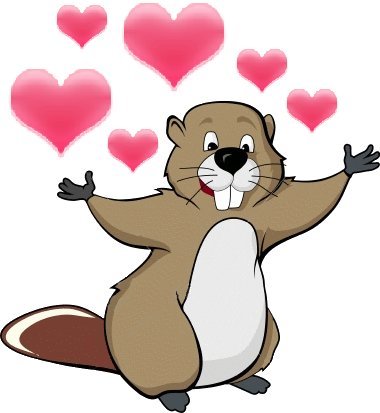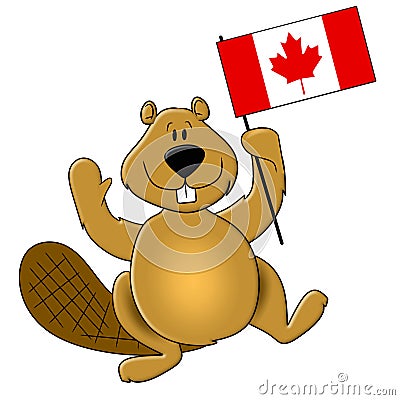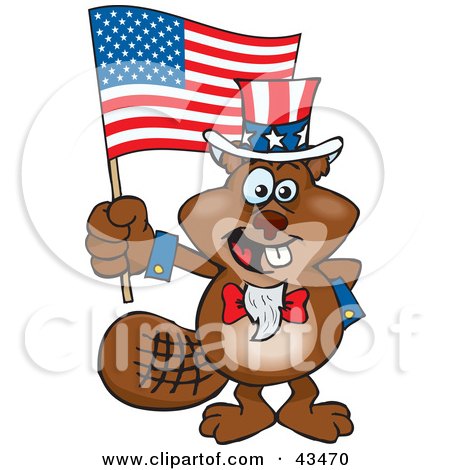Are you afraid of the word beaver? Would you be horrified if someone called you an eager beaver? What would you think if you heard some British type making reference to someone beavering about? Honestly, when you hear or read the word beaver, what comes to mind? Is it this?
Or maybe this?
Actually, the beaver character in Disney's animated adaptation of Winnie the Pooh is named Samuel J. Gopher for reasons unexplained, and doesn't appear in A. A. Milne's original books (but was apparently taken from footage of a beaver character that appeared in Disney's Lady and the Tramp). But I digress.
The reason I bring this up is a news story out of Canada last week, which UPI gave the headline of, Web forces Beaver magazine name change. Now, I don't know about you, but I never read this magazine, never even knew that Canada has a Beaver magazine before, but that doesn't stop me from feigning outrage. Here's the January 12th story out of Winnipeg, the town where Marshall McLuhan began his higher education (so you'd think they'd know better):
Canada's The Beaver magazine is changing its name after 90 years because of online pornography and spam filters, its publishers said.
Deborah Morrison, president of Canada's National History Society and the publisher of the history magazine, told the Canwest News Service the next edition would be renamed Canada's History.
Is this a case of internet scapegoating? Maybe so, but it is not without precedent. Back in 2001, when spam filters were not as prevalent as they are today, an American institution of higher learning, Beaver College, changed its name to Arcadia University. Let me quote from the history section of the Wikipedia entry on this school:
The school was founded in Beaver, Pennsylvania in 1853 as Beaver Female Seminary. [boldface in original]
Yes, that's what it says. Why? What were you thinking? And yes, there is a town, actually a borough of Beaver in Pennsylvania, situated on the Beaver River, and located in Beaver County. In fact, it's the county seat, and there's nothing funny about that either. Anyway, back to the old wiki:
By 1872 it had attained collegiate status, under the auspices of the Methodist Episcopal Church, and was named Beaver College. The school admitted men from 1872 to 1907, then again limited enrollment to women until 1972. In 1925 Beaver College moved east to Jenkintown, Pennsylvania. In 1928, the school acquired the current campus in Glenside. The college operated both the Jenkintown and Glenside campuses into the mid-1960s, when it consolidated all activities onto the Glenside campus. [boldface in original again]
So, what about the name change? Well, read on:
In July 2001, upon attaining university status, Beaver College officially changed its name to Arcadia University. It was thought that a new name would emphasize the school's position as one of the top small institutions of higher learning on the East Coast, and would cement its change in designation from "college" to "university." The decision was also made in part to shed its association with the former commonly derided name. As then-president Bette Landman noted, "[The name] too often elicits ridicule in the form of derogatory remarks pertaining to the rodent, the TV show Leave It to Beaver and the vulgar reference to the female anatomy."
Bette's frank explanation was included in a news story archived at ABCnews.com, written by Ron Todt, and entitled Beaver College Announces New Name. Interestingly, the article say that "the decision was announced just after midnight at a surprise pajama party for students, who were rounded up from residence halls with less than an hour’s notice." No comment on that, please. And after quoting President Landman, Todt went on to note
Beaver College has appeared on David Letterman’s Top 10 list. Conan O’Brien and Howard Stern have made jokes about it. And when Saturday Night Live writers invented an annoying film critic for a recent sketch, they made him a representative of Beaver College campus radio.
The college’s own research shows the school appeals to 30 percent fewer prospective students solely because of the name. And the problems worsened with the rise of the Internet, since some Web filters intended to screen out sexually explicit material blocked access to the Beaver College Web site.
So, maybe we should be applauding Beaver magazine for holding out as long as it did. Returning to the UPI story which was quoting President Deborah Morrison of Canada's National History Society
"To be perfectly blunt about it, 'The Beaver' was an impediment on the Internet," she said. "Unfortunately, sometimes words take on an identity that wasn't intended in 1920, when it was all about the fur trade."
Morrison said research showed women and people under the age of 45 were most likely to dislike the magazine's old name and others were complaining their e-mail spam filters were blocking The Beaver's e-newsletters.
It is the second-oldest magazine in Canada after MacLean's, a weekly news magazine founded in 1905, the news agency said.
This post is starting to get tricky, you know? I mean, here I'm writing about two women presidents presiding over two beaverish name changes, at a time when just saying the word beaver in the workplace can have you brought up on sexual harassment charges (no joke!). And all I really meant to do was to call your attention to an essay by Colby Cosh, a Canadian writer, and an assistant editor at Canada's oldest magazine, Macleans. The article, dated January 21, is entitled Le castor fait tout, which according to my very rusty French means something like the beaver does it all, or the beaver makes everything, or the beaver entirely, or something like that. It doesn't matter, anyway, what's important is what Colby has to say:
I wonder if any of the other Macbloggers have been straining at their imaginations trying to find a PG-rated way to talk about the name change over at Canada’s second-oldest magazine. It took me a while to remember that General Semantics has an answer for this. So: The Beaver, now to become Canada’s History, was named in 1920 for what we’ll call beaver1, the rodent Castor canadensis. The periodical was obliged to make the change because of jokes about and search-engine confusion with beaver2, a colloquialism for an anatomical neighbourhood in the human female.
Aha, you may be saying to yourself, finally we get to the point, a reference to general semantics. And yes indeed, Colby insightfully draws upon the non-Aristotelian principle of non-identity, the topic of my last post, What It Is. And he brings into play the extensional device called indexing, which reminds us that words can have many different meanings, refer to many different "things" or phenomena or events, and also operate on different levels of abstraction (e.g., the beaver pointing to one individual vs. the beaver referring to the entire species). Indexing is a device that is meant to remind us that different meanings of a word should not be equated with one another, that beaver1 is not beaver2. And it is meant to remind us to be more precise with our language than we otherwise would be. But, as was the case for E-Prime as noted in my discussion in my last post What It Is, indexing is not meant to replace the way we talk or write, but rather is an exercise to help us think more clearly and critically, much as it works here for Cosh:
Beaver1 is, for my money, the best of the popular symbols of Canadian nationhood. Unlike the maple leaf, which is utterly unknown west of Lake of the Woods, the beaver1 is ubiquitous throughout Canada, yet is integral to our history as seen from most regional standpoints. (I was well into my twenties before I saw an actual maple leaf. I had always assumed that the silhouette on the flag was heavily stylized; when I saw just how similar the real thing was to the icon, I almost fell down laughing—partly at my own ignorance.) Perhaps the beaver1 and the maple leaf are best understood as representing “Hamiltonian” and “Jeffersonian” aspects of the Empire of the St. Lawrence, the one signifier standing for the agrarian past of our dreams—hot sweets, home cooking, big families pounding taps into trees at sugaring-off time—and the other representing progress, engineering, and the industrial virtues.
Now, I find this rather fascinating, as I had no idea that the maple leaf was a symbol of the eastern elite (it seems Canada has east-west issues just as the U.S. does, Colby being from Edmonton, McLuhan's birthplace). I did know that beavers were an important part of Canada's economic history, as detailed by Harold Innis, who was Canada's leading political economist as well as a foundational media ecology scholar. Innis's study of Canada's fur trade, published in 1930 as The Fur Trade in Canada, is a classic in the field.
And the question of national symbol also rings a (liberty) bell--Benjamin Franklin advocated for the turkey, a bird only found in the new world, over the eagle, as the USA's symbol. Of course, down here the decision was made before the end of the 18th century, whereas Canada did not adopt the maple leaf flag until 1965, when it became independent from Britain, sort of (the Queen of England is still Canada's Queen, and I'm told that Quebec never officially approved their constitution, so in a sense when they said on South Park that Canada is not even a real country, it was not entirely a joke). So Canada's flag for most of its history was the Union Jack, as depicted in this image:
Notice that it is a beaver waving that flag. The flag I remember from my early childhood was an interim flag known as the Red Ensign:
It is a rather handsome banner, with a nautical flair. And of course, the flag that Canada adopted in 1965 was this one:
Well, as it turns out, while we don't have any flags with turkeys on them here in the U.S., we do have a beaver flag ourselves. Sort of. You see, the state flag of Oregon, whose state animal is the beaver, and whose nickname is "the beaver state" (wonder if they are considering changing that as well?), has a beaver on it. Sort of. Here's the official explanation from the Welcome to Oregon website:
State Flag - The state flag is navy blue, with gold lettering and symbols. Adopted in 1925, the flag has the legend, "THE STATE OF OREGON" on the face, written above a shield surrounded by 33 stars. The 33 stars symbolize the fact that Oregon was admitted as the 33rd state. The shield, which is part of the state seal, has the number 1859 written below it. 1859 is the year that Oregon was admitted as a state. The reverse side of Oregon's flag shows a beaver. Oregon is the only state in the union that has a different pattern on the reverse side of their flag.
And here it is, take a gander:
A blog post by New Zealander John Ansell entitled How to compromise your flag praises Canada for its single mindedness in adopting the maple leaf design, stating
I was looking for a flag with a beaver on it. Why?
So you could see what the Canadian flag might have looked like had lovers of their national animal had their way – and why it would be just as nutty to put a kiwi on our flag.
And what did I find? That the beaver is also the state animal of Oregon (the Beaver State!)
And that Oregonians must have been similarly split over having fauna on their flag, because they’re the only state to have a different design on each side.
This will be ammunition for the day – and it’s only a matter of time – when some helpful person suggests that a New Zealand flag have the Union Jack or silver fern on one side and the Southern Cross, kiwi or koru on the other.
Lest you think this discussion is getting badly derailed and otherwise, well, flagging, let's just say that the maple leaf and the beaver are both worthy symbols of national pride (I wonder what Canadian-born general semanticist S. I. Hayakawa thought about the matter?). Well, what do you say?
And that sentiment extends to those of us down here in the U.S. too!
As our not entirely forgotten friend Colby Cosh puts it, Canada has a dialectic between the beaver and the maple leaf (oh no, what was I thinking?):
It would be a great shame indeed if one pole of this dialectic were broken and lost just because of the beaver2 metaphor. I almost feel that The Beaver, as in the magazine, has been derelict in giving up the fight. But it’s not my money. The brand could perhaps have stood up to any amount of silent snickering, but no media organ can afford to offer confusion to search engines and spam filters now. Google is a powerful, underestimated force for prosaicness: just ask any sub-editor who’s been ordered to re-do a charmingly cryptic headline and get rid of the cute irony.
So, we're back to blaming the internet, and Google, rather than blaming Canada, eh? But perhaps the solution lies in some combination of general semantics and the semantic web?
As Google gets smarter, or when some more subtle Nietzschean über-engine displaces it, such problems should disappear. Natural-language computing will, sooner or later, be able to tell whether a searcher or questioner is concerned with beaver1 or beaver2. The funny thing is, the beaver2 metaphor may have long since disappeared by then, and the story of why The Beaver had to change its name may be an incomprehensible piece of trivia as far as the future is concerned. “Beaver2” is already an outmoded vulgarism, something I would expect to hear spilling out of the mouth of a person my father’s age rather than a 30-year-old.
An excellent point. Languages change over time, the meanings of words evolve and some words become archaic, and slang changes especially quickly, being essentially oral rather than fixed in writing. Egad! Zounds! Don't be such a ninnyhammer, blaggard, and winnit! Okay, sorry, I'm interrupting, so back to Mr. Cosh:
And we all know why: beavers2 aren’t seen in photographs or on video with their defining pelt very often anymore. Feminine depilation has become the norm—certainly not in everyday life, but in the visual culture. As a consequence, in all-male environments of the sort signified by the “locker room”, the favourite metaphors of today emphasize different sensory aspects of the part in question. This is true even where the context involves a strictly visual encounter: the beaver2 is not only called that because of its fur, but also because a gentleman is invariably excited to have caught a glimpse of one, as it were, in the wild. (Think about Jim Bouton’s discussion in Ball Four of the baseball player’s “beaver2 shooting” hobby.)
And speaking of language, come on, we really have to hand it to Colby for the subtle way in which he is handling the subject, successfully discussing the subject in PG terms. And he continues
While reports of the extinction of the beaver2 are much exaggerated, North America’s experience of sudden shifts toward leg and armpit depilation suggest that women will change their grooming habits to match the visual culture. And not in the “long run”, either, but in a matter of a few years. There is no evidence that there will ever be any mass anti-depilation backlash. If you are a traditionalist sort who has been waiting around for one, you have already been waiting quite a while. The arc of history bends toward bareness. (Indeed, it does so even when it comes to men’s bodies.)
This is actually a very insightful point that he is making, about the effect of what he calls visual culture on personal grooming. I would just prefer to use the phrase image culture instead, because the contemporary media environment is not so much characterized by the ascendancy of vision, which after all is very much associated with reading, writing, and printing, as it is with the rise of graphic images via mechanical reproduction, photography, motion pictures, video, and now digital media. McLuhan associates literacy with visualism (as does Walter Ong), while Neil Postman, Daniel Boorstin, Susan Sontag, Walter Benjamin and others concern themselves with 20th century image culture.
And the depilatory phenomenon that Colby refers to strikes me as an extension of our overemphasis on cleanliness in American culture, antiseptic, antibacterial, antibiotic. And deoderized as well--my first scholarly publication was a piece on media and the sense of smell where I suggested some of these ideas (it appears in the 2nd and 3rd editions of the Inter/Media reader edited by Gary Gumpert and Robert Cathcart). Anyway, Cosh concludes with a question:
So it seems near-certain that we will, one day, be able to speak of the beaver1 without the suppressed giggles. But will it still be associated with Canada, or will the symbol have been irretrievably relegated to the semiotic landfill?
I suspect that Colby is right, and I wouldn't be surprised if the beaver1 symbol is retrieved and reclaimed by Canadians at some point in the future, and maybe even by Oregonians and Arcadians. But for now, these changes seem to suggest that we North Americans have the collective maturity of the Beavis and Butthead cartoon characters, speaking of which (and warning, the following contains obscene language and adult situations):
So, what is there left for me to say but, be afraid, beavery afraid, be very very afraid, and....
DAM!!!!



















